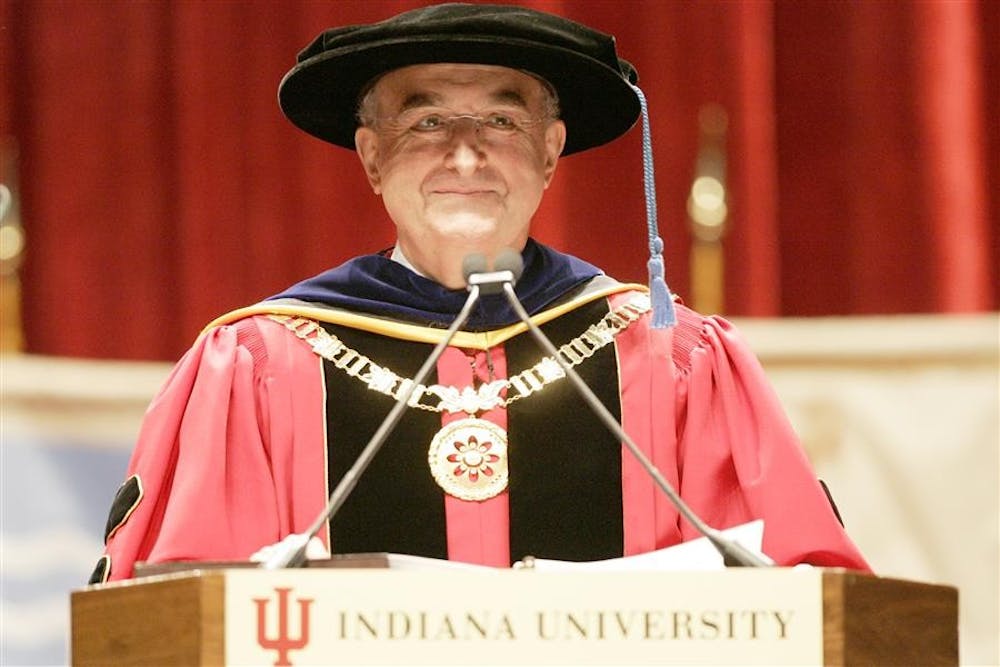IU President Michael McRobbie is aware of the shoes he has to fill. He’s surrounded by reminders — the bust of Herman B Wells in his conference room and the library that bears the legendary president’s name. But some say McRobbie has already filled them.
“We are very blessed to have Dr. McRobbie,” Trustee Philip Eskew said during a Board of Trustees meeting in July 2011. “And I hail him as IU’s modern-day Herman Wells.”
It’s difficult to compare anyone to Wells, who during his 30 years as president tripled student enrollment, expanded the University internationally, increased campus acreage from 137 to 1,700 and advocated for equal treatment of people of all races at IU. But arguably as prolific is the age of change McRobbie has implemented since he was hired in 2007.
In just seven years, McRobbie has overseen the transformation of seven schools within the University, led an acceleration in information technology and cyberinfrastructure and increased funding from big name donors to help pull IU from economic turmoil.
McRobbie takes full ownership for these changes.
“I think it all started with me,” he said, chuckling, during a recent, rare interview with the Indiana Daily Student.
It’s been an age of digitization, professionalization and consolidation brought on by two leading factors — state funding cuts and advancing technology.
But like all change, it could come at a price.
With the creation of new schools, the merging of existing ones and the elimination of others, some students, faculty and staff are fearful that the traditions and community long associated with these units are being sacrificed in the name of efficiency.
“If you keep cutting, cutting and cutting,” said Associate Professor and Herman B Wells Historian James Capshew, “you’re going to cut the heart of campus.”
***
Before the whirlwind of structural changes at IU, the University’s academic units hadn’t seen change this drastic since the early 20th century.
Adam Herbert, the president before McRobbie, only served three years before stepping down from the position, following a period of disgruntlement from IU faculty.
His lack of visibility on campus and failure to collaborate with faculty, according to news reports at the time, gave them little confidence in his ability to lead IU. At the end of 2005, the faculty called upon the Board of Trustees to review Herbert’s job performance.
In January 2006, Herbert wrote a letter to the board expressing his wish to leave the University when his contract was set to expire in July 2008.
That meant IU had more than two years to find a new president, but many institutional leaders, including some trustees, felt they couldn’t wait that long.
“What was happening in the world was that the good universities were getting better,” current Board of Trustees Chairman Tom Reilly said, reflecting on the tensions back then. “We came to several conclusions, and one was that Bloomington needed leadership.”
Before they formed a presidential search committee, though, an administrative reorganization took place at the recommendation of Herbert. Just days after Herbert penned his letter to the trustees, McRobbie, then vice president for research and vice president for information technology, was named IU’s first interim provost.
The new position replaced IU-Bloomington’s chancellor position. Before that, IU-Bloomington had a chancellor who answered directly to the Bloomington-located president, just like all IU regional campuses across the state. But it seemed unnecessary to have both the president of the University and a chancellor in Bloomington, Reilly said, so they cut the position at IU-Bloomington.
The provost’s job would be to oversee all academic entities at IU-Bloomington but allow the University president to have a stronger role in the flagship campus.
Once they filled the new provost position, a presidential search committee formed in June 2006.
Reilly and Lauren Robel, then dean of the Maurer School of Law, both served on the search committee and now hold prominent, powerful positions within IU. Reilly is chair of the Board of Trustees and Robel is provost and executive vice president.




